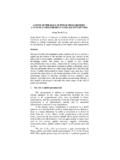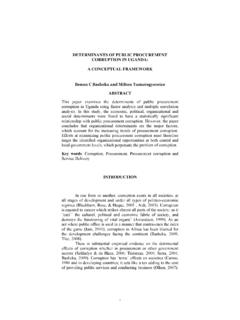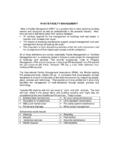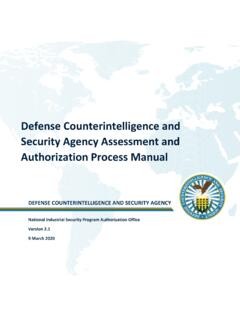Transcription of CRITICAL SUCCESS FACTORS IN GOVERNMENT …
1 1 CRITICAL SUCCESS FACTORS IN GOVERNMENT CONTRACT MANAGEMENT Rene G. Rendon Rene G. Rendon, , is Associate Professor of Acquisition Management in the Graduate School of Business and Public Policy at the Naval Postgraduate School in Monterey, California. His teaching and research interests are in supply management, contract management, and project management. ABSTRACT CRITICAL SUCCESS FACTORS have a direct impact on an organization s project management and contract management processes as well as resulting outcomes. This paper presents the results of survey-based research on contract management CRITICAL SUCCESS FACTORS , derived from the responses of approximately 400 contracting officers who represent 7 Department of Defense (DoD) agencies. The principal contributions of this paper are to show the similarities in both project management and contract management CRITICAL SUCCESS FACTORS and the implications for the DoD.
2 The overall conclusion is that focusing on these CRITICAL SUCCESS FACTORS can improve the DoD s management of both projects as well as contracts. The recommendation is that the DoD should focus on the common knowledge areas and processes impacting project management and contract management by addressing the identified CRITICAL SUCCESS FACTORS in the areas of individual competencies and organizational structures and processes. INTRODUCTION The United States federal GOVERNMENT continues to increase its level of public spending for supplies and services. Within the federal GOVERNMENT , the Department of Defense (DoD) is the largest contracting agency, procuring approximately $370 billion in FY2009 (FPDS, 2010). This was an increase from $133 billion in FY2000. The DoD acquisition workforce professionals are responsible for managing over 3 million contract actions for the procurement of CRITICAL supplies and services, ranging from commercial-type supplies, professional and administrative services, highly complex information technology systems, and major defense weapon systems (FPDS, 2010).
3 2 The extent and amount of defense procurement spending necessitates that these contract management processes be well managed (Thai, 2004). However, this is not necessarily the case. Between 2001 and 2009, the GOVERNMENT Accountability Office (GAO) has issued 16 reports related to trends, challenges, and deficiencies in federal GOVERNMENT contracting. Also, between 2002 and 2008, the DoD Inspector General (DoD IG) issued 142 reports on deficiencies in the DoD acquisition and contract administration processes. These reports have identified project management and contract management as some of the CRITICAL deficient areas in DoD contracts. The essence of DoD contract management is the proper planning, award, and administration of contracts and the oversight of contractor performance (Rendon & Snider, 2008). The lack of effective contract administration and contractor oversight increases the GOVERNMENT s risk of jeopardizing the total value for the dollars spent on supplies and services.
4 GAO and DoD IG reports have consistently identified contract administration and contractor oversight as problem areas in the management of service contracts (GAO, 2005; GAO, 2007; OIG, 2009). The DoD is at risk of paying higher prices than necessary for supplies and services. Because of this, the GAO has identified DoD contract management as a high-risk area since 1992 (GAO, 2009, January). This high-risk status reflects the DoD s challenges in achieving desired outcomes in terms of meeting procurement cost, schedule, and performance objectives. In response to this high-risk rating, the DoD is placing an extensive emphasis in the areas of education, training, and the development of workforce competence models (Newell, 2007; GAO, 2009, March). In addition to a focus on increasing individual contract management competency, organizations are now focusing on increasing organizational contract management competence through the use of organizational process maturity models (Rendon, 2009b).
5 Just as individual competence will lead to greater SUCCESS in performing tasks, organizational process capability will ensure consistent and superior results for the enterprise (Frame, 1999; Kerzner, 2001; Garrett & Rendon, 2005). A stream of research has been generated on organizational contract management process capability. The research is focused on assessing an organization s contract management process capability and using the assessment results for determining and implementing process capability improvement initiatives. A Contract Management Maturity Model (CMMM) was first developed and then applied to an Air Force space systems contracting agency (Rendon, 2003). The CMMM was then 3applied at various Air Force, Army, and Navy contracting agencies for the purpose of assessing contract management process capability and identifying process improvements, as well as obtaining empirical data for use in characterizing the state of contract management process capability throughout the DoD (Rendon, 2008; Rendon, 2009b).
6 The CMMM organizational assessments have also resulted in obtaining empirical data on contract management CRITICAL SUCCESS FACTORS . CRITICAL SUCCESS FACTORS have a direct influence on an agency s project management and contract management processes and resultant projects and contracts. Contract management and project management are integrally related. The management of projects typically includes planning, awarding, and administering contracts for the performance of the project-related effort. Effective contract administration is integral to successful project management. Contract administration has often been described as putting the teeth in project monitoring and control (Rendon, 2009a, p. 70). Indeed, the close relationship between project management and contract management is reflected in the Project Management Institute s Guide to the Project Management Body of Knowledge (PMBOK Guide) (PMI, 2008) as well as the National Contract Management Association s Annotated Guide to the Contract Management Body of Knowledge (CMBOK) (NCMA, 2006).
7 The PMBOK Guide includes a discussion of the procurement knowledge area, and the CMBOK includes a discussion of project management aspects of managing contracts. The recent reports from the GAO and the DoD IG identify both project management and contract management as deficiencies in the DoD s contracts. Thus, both project management and contract management are CRITICAL processes for the DoD. If successful project management and contract management processes are CRITICAL for the SUCCESS of the DoD s acquisition mission, how do CRITICAL SUCCESS FACTORS for project management compare with CRITICAL SUCCESS FACTORS for contract management? This is the focus of this research. This paper presents the results of survey-based research on contract management CRITICAL SUCCESS FACTORS , derived from the responses of approximately 400 contracting officers who represent 7 DoD agencies.
8 An analysis of the survey responses is conducted to identify similarities between the survey responses and the CRITICAL SUCCESS FACTORS identified in the project management and contract management literature. The purpose of this paper is to compare the project management and contract 4management CRITICAL SUCCESS FACTORS as identified in the literature with the contract management CRITICAL SUCCESS FACTORS indentified in our survey-based research. The principal contributions of this paper are to show the similarities in both project management and contract management CRITICAL SUCCESS FACTORS and to discuss the implications for the DoD in terms of individual and organizational competence. The overall conclusion is that focusing on these CRITICAL SUCCESS FACTORS can improve the DoD s management of both its projects and its contracts. This paper is organized in four sections.
9 The remainder of this first section provides a brief background on the theoretical framework and a literature review on identifying CRITICAL SUCCESS FACTORS in project management and contract management. In the second section, I discuss the research methods, followed by the third section on research findings and results. Finally, in the fourth section I present a discussion of the identified CRITICAL SUCCESS FACTORS and compare them with the literature. Theoretical Framework Academic research in contract management is founded on several economic and management theories, the most often referred to is agency theory (Eisenhardt, 1989). A contract between the GOVERNMENT and a contractor reflects a principal- agent relationship. The principal ( GOVERNMENT ) contracts with the agent ( contractor ) to perform some level of effort, such as developing or manufacturing a product or providing a service.
10 In this relationship, the GOVERNMENT s objectives include obtaining the product or service at the right quality, right quantity, right source, right time, and at the right price (Lee & Dobler, 1971). The federal GOVERNMENT also has the additional objective of ensuring the product or service is procured in accordance with public policy and statutory requirements (FAR, 2010). Contractors, on the other hand pursue the objectives of earning a profit, ensuring company growth, maintaining or increasing market share, and improving cash flow, just to name a few. Because of the different and conflicting objectives between the principal and agent , each party is motivated and incentivized to behave in a certain manner. This behavior includes either withholding or sharing information. In principal- agent relationships that involve higher levels of uncertainty, which result in higher risk (such as developing an advanced technology weapon system), the information available to the GOVERNMENT and contractor is typically asymmetrical.
















